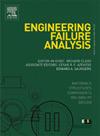Effects of shot peening intensity and coverage on the fatigue life and fracture characteristics of DZ125 alloy at room and high temperatures
IF 4.4
2区 工程技术
Q1 ENGINEERING, MECHANICAL
引用次数: 0
Abstract
Nickel-based superalloys are widely used in aerospace and other fields, with their fatigue life being one of the crucial factors affecting their reliability and performance. To extend the fatigue life of the DZ125 alloy, the high-temperature (760 °C) and room-temperature (25 °C) fatigue properties under different shot peening (SP) parameters were studied. For circumferential V-notch (kt = 2.5) samples of the DZ125 alloy, SP was conducted using S110 shots with Almen intensities of 0.21mmA and 0.17mmA and coverage rates of 100 %, 200 %, and 300 %. The fatigue life is evaluated using an SP simulation method based on finite element and discrete element method (FEM-DEM) coupling, combined with surface residual stress and roughness testing. The results showed that when the sample coverage rate increased from 200 % to 300 %, the surface residual compressive stress has little difference, and the roughness increased from 2.1 μm to 2.63 μm, consistent with simulation results. SP can improve the fatigue life of DZ125 alloy. When the Almen intensity and coverage of 0.17mmA and 200 % respectively, the fatigue performance is the best. At high temperatures, the fatigue life of specimens with 300 % coverage is 1/6 that of those with 200 % coverage, while in a normal temperature environment, the fatigue life of specimens with 300 % coverage is not significantly lower than those with 200 % coverage. This indicates that when SP coverage is excessive, there surface defects causing surface stress relaxation. Under the influence of high temperatures, there is an oxidation damage process at the crack tip that promotes crack initiation and propagation, reducing fatigue life. The research results provide improved methods and experimental basis for enhancing the fatigue life of the DZ125 alloy.
喷丸强化强度和覆盖率对 DZ125 合金在室温和高温下的疲劳寿命和断裂特性的影响
镍基超合金广泛应用于航空航天和其他领域,其疲劳寿命是影响其可靠性和性能的关键因素之一。为了延长 DZ125 合金的疲劳寿命,研究了不同喷丸强化(SP)参数下的高温(760 °C)和室温(25 °C)疲劳性能。对于 DZ125 合金的圆周 V 形缺口(kt = 2.5)样品,采用 S110 喷丸进行强化,阿尔门强度分别为 0.21mmA 和 0.17mmA,覆盖率分别为 100%、200% 和 300%。使用基于有限元和离散元方法(FEM-DEM)耦合的 SP 模拟方法,结合表面残余应力和粗糙度测试,对疲劳寿命进行了评估。结果表明,当试样覆盖率从 200 % 增加到 300 % 时,表面残余压应力差别不大,粗糙度从 2.1 μm 增加到 2.63 μm,与模拟结果一致。SP 可以提高 DZ125 合金的疲劳寿命。当 Almen 强度和覆盖率分别为 0.17mmA 和 200 % 时,疲劳性能最好。在高温环境下,覆盖率为 300% 的试样的疲劳寿命是覆盖率为 200% 的试样的 1/6,而在常温环境下,覆盖率为 300% 的试样的疲劳寿命并不明显低于覆盖率为 200% 的试样。这表明,当 SP 覆盖率过高时,表面缺陷会导致表面应力松弛。在高温影响下,裂纹尖端会出现氧化损伤过程,促进裂纹的产生和扩展,从而降低疲劳寿命。研究结果为提高 DZ125 合金的疲劳寿命提供了改进方法和实验依据。
本文章由计算机程序翻译,如有差异,请以英文原文为准。
求助全文
约1分钟内获得全文
求助全文
来源期刊

Engineering Failure Analysis
工程技术-材料科学:表征与测试
CiteScore
7.70
自引率
20.00%
发文量
956
审稿时长
47 days
期刊介绍:
Engineering Failure Analysis publishes research papers describing the analysis of engineering failures and related studies.
Papers relating to the structure, properties and behaviour of engineering materials are encouraged, particularly those which also involve the detailed application of materials parameters to problems in engineering structures, components and design. In addition to the area of materials engineering, the interacting fields of mechanical, manufacturing, aeronautical, civil, chemical, corrosion and design engineering are considered relevant. Activity should be directed at analysing engineering failures and carrying out research to help reduce the incidences of failures and to extend the operating horizons of engineering materials.
Emphasis is placed on the mechanical properties of materials and their behaviour when influenced by structure, process and environment. Metallic, polymeric, ceramic and natural materials are all included and the application of these materials to real engineering situations should be emphasised. The use of a case-study based approach is also encouraged.
Engineering Failure Analysis provides essential reference material and critical feedback into the design process thereby contributing to the prevention of engineering failures in the future. All submissions will be subject to peer review from leading experts in the field.
 求助内容:
求助内容: 应助结果提醒方式:
应助结果提醒方式:


